 In all passions you will find lovers and users. The vintage motorcycle passion, looking backwards towards a rose-tinted youth seems to have more than its share of both. Most vintage motorcycle enthusiasts are into the hobby because they either had a particular model or dreamed of owning a particular model way back when they were freshly weaned from the teat of childhood. Powerful first impressions drill that Yamaha RT1 or Kawasaki Z1B into a youngster’s brain like the clean, soapy scent of their first girlfriend’s hair.
In all passions you will find lovers and users. The vintage motorcycle passion, looking backwards towards a rose-tinted youth seems to have more than its share of both. Most vintage motorcycle enthusiasts are into the hobby because they either had a particular model or dreamed of owning a particular model way back when they were freshly weaned from the teat of childhood. Powerful first impressions drill that Yamaha RT1 or Kawasaki Z1B into a youngster’s brain like the clean, soapy scent of their first girlfriend’s hair.
Dreamers will spare no expense to make the fantasy whole, a living breathing relic of their past that they can ride today. The sounds of an old two-stroke twin can bring tears; the fierce kickback from an ancient thumper calls forth the rare, crystal clear memory along with an aching foot. When the time comes that they must sell their pride and joy to pay for an assisted living facility, Dreamers care about the motorcycle going to a good home, to someone who will appreciate the motorcycle as much as they did.
Not so the Flipper. The Flipper sees everything in dollars and cents. His only concern is extracting the maximum amount of cash from the Dreamers. The Flipper appears to share our enthusiasm and in fact may be knowledgeable about old motorcycles but his is a clinical, product knowledge. The Flipper could be selling Pokémon cards or Barbie dolls still in the original packaging and feel nothing for any of it.
The Flipper, egged on by TV shows glorifying the act of preying on the uneducated, scavenges the countryside looking for old motorcycles to buy at below market rates. Or steal in real terms. He then raises the price to astronomical levels and pops the thing on eBay to watch the Dreamers bid the thing even higher. Widows, children settling an estate or ex-wives exacting revenge on unfaithful husbands fuel the Flipper’s trade in misery.
Some Flippers don’t bother to learn their product line. You’ll see them on vintage motorcycle chat sites posting up a part or an entire motorcycle and asking, “What is this and what’s it worth?” They actually want to know model and year so they can eBay the thing. It’s a lazy Flipper that buys on appearance alone.
There’s nothing inherently wrong with the buy low-sell high business model except when passion enters into the process. Flippers, through their actions, drive up the cost of vintage motorcycling for the Dreamers. His great financial gains encourage other Dreamers to sell out their childhood memories and become Flippers themselves. With a finite supply of product this process of devouring our own eventually attracts the Collectors.
Collectors have a Flipper’s business sense along with the money to back it up. They don’t need to sell anything ever. When a collector dies an auction house usually disposes of his motorcycles to an audience comprised of 90% Collectors and 10% Dreamers. Flippers know there are no good deals at an auction. By withholding product from the market the Collector also helps drive up costs for those of us who just want an old motorcycle to ride.
This cycle of driving up costs continues until people who don’t really give a crap about them own all the old motorcycles. The Dreamers are priced out of the market and go on to other hobbies like heart surgery or knee replacement. As the generations that originally desired the motorcycles begin to die off the prices will drop and the Flippers, seeing a contracting market, will move on to destroy another fun, economical hobby. Like model trains.
There is no solution to the Flipper problem. Events must follow their course and human nature cannot be denied. Profit wins over passion every time. It’s enough that we loved the old bikes for what they were. Our memories will not be for sale.

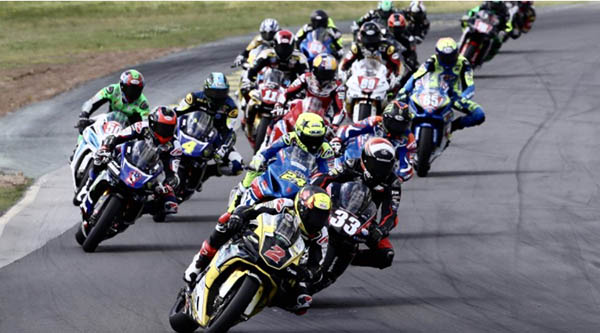 Motorcycle road racing in America has not met expectations for quite a while now. Our guys are no longer dominating GP racing as they did in decades past. MotoAmerica, our premier road racing league has made strides by reinstalling the 1000cc bikes as the premier class and bumping the 600’s down to B-team. Hiring my Internet-buddy Andrew Capone as rainmaker for the series is another great move towards professional sponsorship and revenue generation. I’ve never raced on pavement but I rank as an expert spectator due to the sheer number of road races I’ve attended. I’ve got a few ideas on how to make MotoAmerica better and I’m not shy about cranking them out.
Motorcycle road racing in America has not met expectations for quite a while now. Our guys are no longer dominating GP racing as they did in decades past. MotoAmerica, our premier road racing league has made strides by reinstalling the 1000cc bikes as the premier class and bumping the 600’s down to B-team. Hiring my Internet-buddy Andrew Capone as rainmaker for the series is another great move towards professional sponsorship and revenue generation. I’ve never raced on pavement but I rank as an expert spectator due to the sheer number of road races I’ve attended. I’ve got a few ideas on how to make MotoAmerica better and I’m not shy about cranking them out.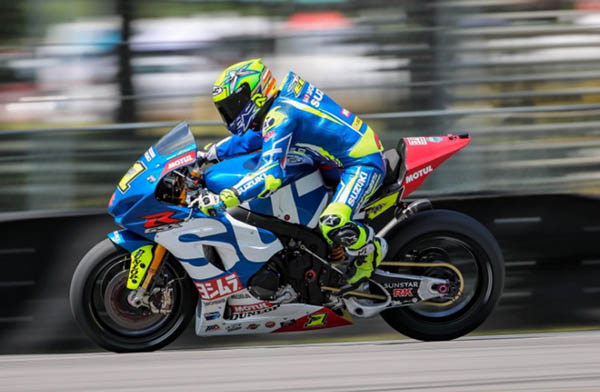 American road racers are never going to get back atop the pinnacle of GP racing until they test themselves against the world’s best. It’s expensive for a US rider to got to Europe so why not bring Europe to the USA? What if all the contract issues could be solved and MotoAmerica paid start money to a few of the GP guys? Pay Rossi to start a few races, Marquez or Dovizioso would be a huge draw. I’m guessing the increased gate alone would pay for Rossi. This harkens back to when European motocross stars were paid to compete over here. American racers gained first hand experience on where they needed to be in order to defeat the best. There is no physical barrier preventing our top AMA racers from competing on even terms with world-class GP racers. Show our greyhounds the European rabbit and they will move heaven and earth to stay on their tail.
American road racers are never going to get back atop the pinnacle of GP racing until they test themselves against the world’s best. It’s expensive for a US rider to got to Europe so why not bring Europe to the USA? What if all the contract issues could be solved and MotoAmerica paid start money to a few of the GP guys? Pay Rossi to start a few races, Marquez or Dovizioso would be a huge draw. I’m guessing the increased gate alone would pay for Rossi. This harkens back to when European motocross stars were paid to compete over here. American racers gained first hand experience on where they needed to be in order to defeat the best. There is no physical barrier preventing our top AMA racers from competing on even terms with world-class GP racers. Show our greyhounds the European rabbit and they will move heaven and earth to stay on their tail. If you roll along dusty, unpaved county road A011 through the desert shrubbery of New Mexico’s south-central region, and you roll with purpose, you will fetch up on the shores of Kilbourne Crater. Kilbourne was formed by a maars-type volcanic eruption. In a maars eruption a crater is created by hot magma coming into contact with the water table. When the two meet, the rapidly heated water turns to steam, expands and blows huge chunks of ground skyward. By huge I mean 2.5 kilometers across 1.8 kilometers wide and 125 meters deep. It’s a big hole and it must have made quite a racket when it blew its stack 20,000 to 80,000 years ago.
If you roll along dusty, unpaved county road A011 through the desert shrubbery of New Mexico’s south-central region, and you roll with purpose, you will fetch up on the shores of Kilbourne Crater. Kilbourne was formed by a maars-type volcanic eruption. In a maars eruption a crater is created by hot magma coming into contact with the water table. When the two meet, the rapidly heated water turns to steam, expands and blows huge chunks of ground skyward. By huge I mean 2.5 kilometers across 1.8 kilometers wide and 125 meters deep. It’s a big hole and it must have made quite a racket when it blew its stack 20,000 to 80,000 years ago. Maars volcanic eruptions don’t form the classic Hanna-Barbera, cinder cone shape or leave behind crowd-pleasing lava flows. At first I thought a meteor caused the crater but the crew at Southwest Expeditions had several guest speakers situated under a billowing tent to set me straight. They also had a van if you didn’t want to burn your own fuel to get to the crater. I saved $2.57. In addition to downloading a heck of a lot of information about volcanism into the assembled masses they served us a fine chicken-taco lunch.
Maars volcanic eruptions don’t form the classic Hanna-Barbera, cinder cone shape or leave behind crowd-pleasing lava flows. At first I thought a meteor caused the crater but the crew at Southwest Expeditions had several guest speakers situated under a billowing tent to set me straight. They also had a van if you didn’t want to burn your own fuel to get to the crater. I saved $2.57. In addition to downloading a heck of a lot of information about volcanism into the assembled masses they served us a fine chicken-taco lunch. Lunch was fabulous except for one thing. That thing being a giant jar of sliced jalapenos. No one was eating them because the lid was too tight. I gave it a good twist but the lid would not budge. I’m not the strongest guy in the world but I can open a damn jalapeno jar, you know? I finally gave up and handed it to this big guy that looked like Chief from the movie One Flew Over The Cuckoo’s Nest. I swear, he took the lid in his fingertips and the lid spun off easy as pie.
Lunch was fabulous except for one thing. That thing being a giant jar of sliced jalapenos. No one was eating them because the lid was too tight. I gave it a good twist but the lid would not budge. I’m not the strongest guy in the world but I can open a damn jalapeno jar, you know? I finally gave up and handed it to this big guy that looked like Chief from the movie One Flew Over The Cuckoo’s Nest. I swear, he took the lid in his fingertips and the lid spun off easy as pie. It put a damper on my lunch I tell you. I ate moody qua-moody. Am I getting old? Will I need a Clap-On soon? Life Alert? After the jar debacle it was probably best that Southwest Expeditions canceled our hike down into the crater. The temperature was 92 degrees and the wind was howling. No sense crushing anyone else’s sense of self-worth.
It put a damper on my lunch I tell you. I ate moody qua-moody. Am I getting old? Will I need a Clap-On soon? Life Alert? After the jar debacle it was probably best that Southwest Expeditions canceled our hike down into the crater. The temperature was 92 degrees and the wind was howling. No sense crushing anyone else’s sense of self-worth. The reason for all of this activity in the middle of nowhere was the 50th anniversary of astronauts Conrad, Bean, Gibson, Carr, Irwin and Schmitt training in Kilbourne Crater for their upcoming Apollo 12 Moon mission. That would be the second Moon landing. Kilbourne was chosen for its dust, the rough terrain and the multitude of geologic examples found at the site.
The reason for all of this activity in the middle of nowhere was the 50th anniversary of astronauts Conrad, Bean, Gibson, Carr, Irwin and Schmitt training in Kilbourne Crater for their upcoming Apollo 12 Moon mission. That would be the second Moon landing. Kilbourne was chosen for its dust, the rough terrain and the multitude of geologic examples found at the site. Other Apollo missions trained at Kilbourne: Apollo 13, 14, 15 (canceled), 16 (renamed 15) and 17 crews all did their time in the hole. NASA’s budget and our will to explore the Moon waned and the Apollo missions kind of ran out of steam. Which, in a suitable ending is what created their moon-mission training ground those many years ago. Maybe one day NASA will return to Kilbourne and use its dusty, rocky landscape to train another generation of astronauts. I hope to see America once again become a space-faring nation and that those astronauts will be heading to Mars.
Other Apollo missions trained at Kilbourne: Apollo 13, 14, 15 (canceled), 16 (renamed 15) and 17 crews all did their time in the hole. NASA’s budget and our will to explore the Moon waned and the Apollo missions kind of ran out of steam. Which, in a suitable ending is what created their moon-mission training ground those many years ago. Maybe one day NASA will return to Kilbourne and use its dusty, rocky landscape to train another generation of astronauts. I hope to see America once again become a space-faring nation and that those astronauts will be heading to Mars.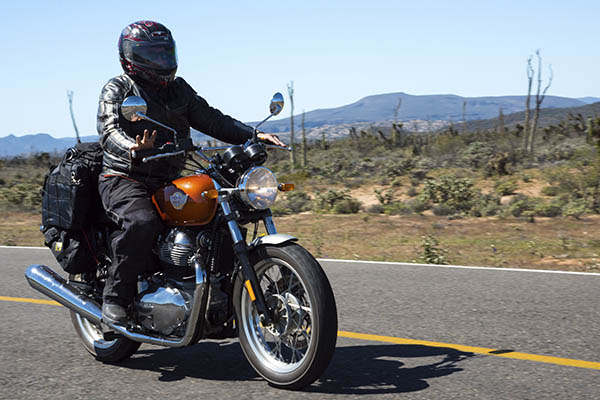 When I saw the first photographs of Royal Enfield’s new 650 twin the bike seemed perfect. 650 vertical twins have owned the sweet-spot of cool long before McQueen bashed them around the desert and they are still an ideal size and configuration for all around use. Unfortunately the latest vertical twin offerings from other motorcycle manufacturers have sprouted slow-moving tumorous pistons, lost their summer beach-bodies and become uselessly complex. The whole situation kind of put me on edge. I was actually a bit angry: “Royal Enfield better not screw this up,” I mumbled to my cat.
When I saw the first photographs of Royal Enfield’s new 650 twin the bike seemed perfect. 650 vertical twins have owned the sweet-spot of cool long before McQueen bashed them around the desert and they are still an ideal size and configuration for all around use. Unfortunately the latest vertical twin offerings from other motorcycle manufacturers have sprouted slow-moving tumorous pistons, lost their summer beach-bodies and become uselessly complex. The whole situation kind of put me on edge. I was actually a bit angry: “Royal Enfield better not screw this up,” I mumbled to my cat.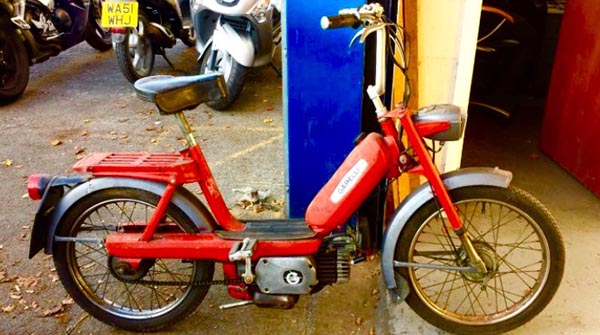 At one time I owned a 1973 BMW R75/5 motorcycle. I traded 1300 dollars and a 1957 small-window VW van for the BMW. The good points about the bike were the suspension and the weight. For a 750cc the bike was lightweight and the thing had plenty of fork travel so it worked pretty good off road. The bad part was the charging system. I never could get the damn thing to electric start due to the battery being low. At the time I tried everything I knew to fix it but the little red discharge light was on constantly.
At one time I owned a 1973 BMW R75/5 motorcycle. I traded 1300 dollars and a 1957 small-window VW van for the BMW. The good points about the bike were the suspension and the weight. For a 750cc the bike was lightweight and the thing had plenty of fork travel so it worked pretty good off road. The bad part was the charging system. I never could get the damn thing to electric start due to the battery being low. At the time I tried everything I knew to fix it but the little red discharge light was on constantly.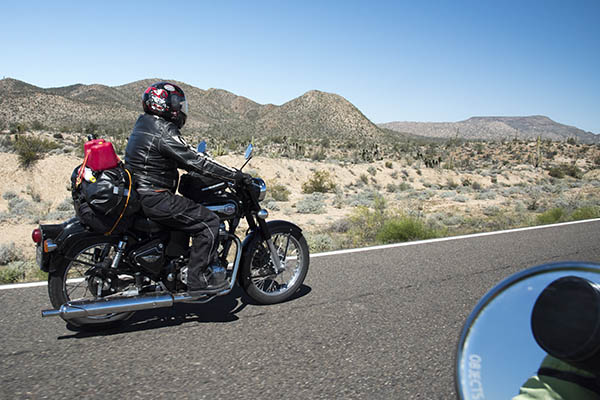 Everything Joe Berk has written about the Bullet’s shaky performance on our Baja tour is true, but like our President’s spokeswoman has said, there are alternative facts in addition to real facts.
Everything Joe Berk has written about the Bullet’s shaky performance on our Baja tour is true, but like our President’s spokeswoman has said, there are alternative facts in addition to real facts.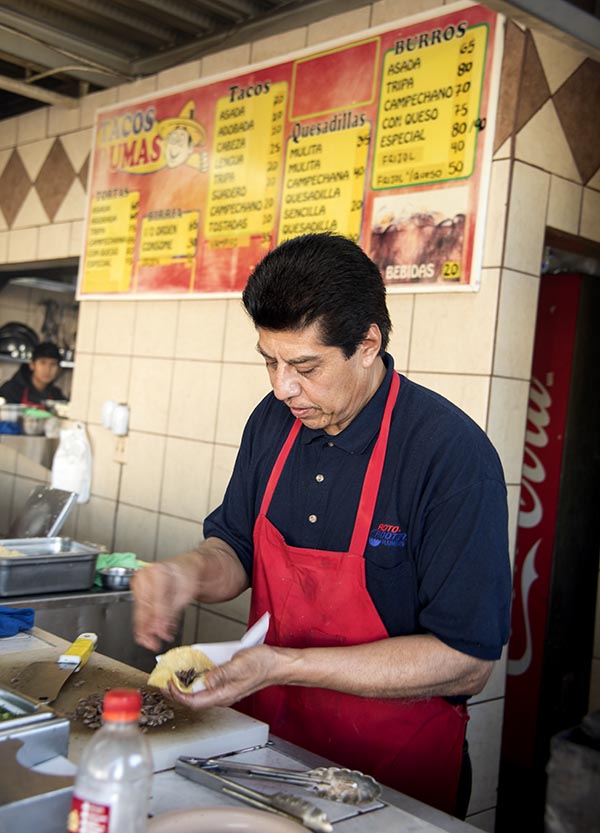 Most of our time riding Royal Enfield motorcycles through Baja is spent eating. We have breakfast then ride a while. Any time between 10am and 2 pm is lunch time followed by a rolling dinner that lasts several hundred miles.
Most of our time riding Royal Enfield motorcycles through Baja is spent eating. We have breakfast then ride a while. Any time between 10am and 2 pm is lunch time followed by a rolling dinner that lasts several hundred miles.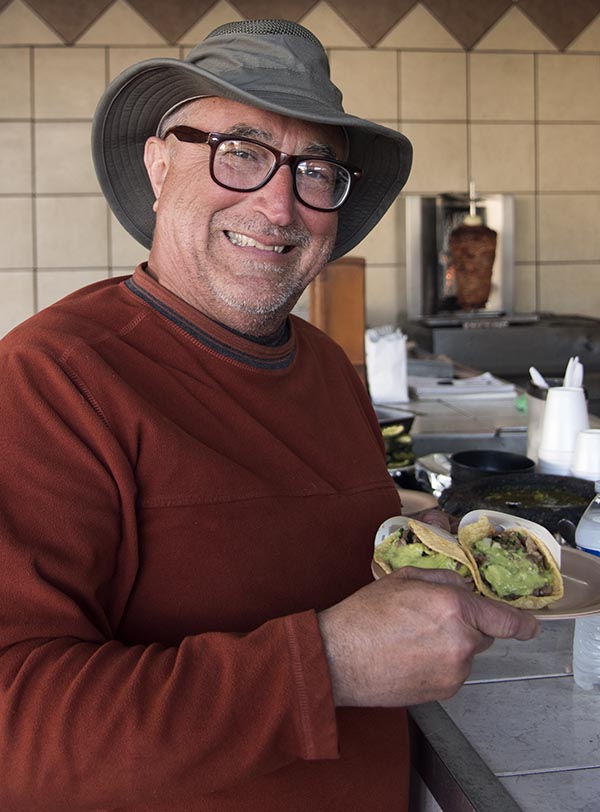
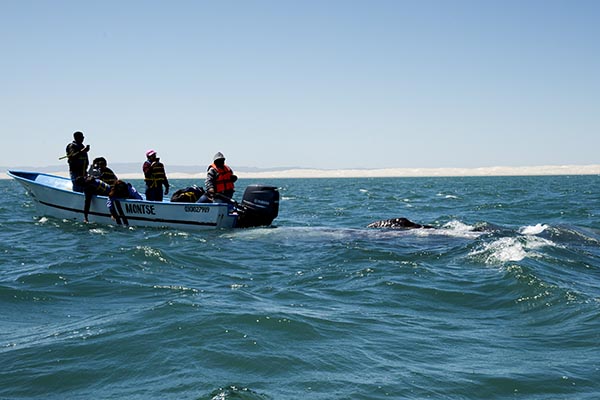 Did I ever tell you I’ve been on two boats that sunk? No? Ah well, It’s a story for another blog another day. Bounding out into Guerrero Negro’s bay our low-gunneled pongas were kicking up rainbow waves and a light, salty mist settled over the occupants.
Did I ever tell you I’ve been on two boats that sunk? No? Ah well, It’s a story for another blog another day. Bounding out into Guerrero Negro’s bay our low-gunneled pongas were kicking up rainbow waves and a light, salty mist settled over the occupants. Berk was feeling pretty frisky about the Bullet. We had cleaned up a corroded spark plug cap and the big 500cc single was running well.
Berk was feeling pretty frisky about the Bullet. We had cleaned up a corroded spark plug cap and the big 500cc single was running well.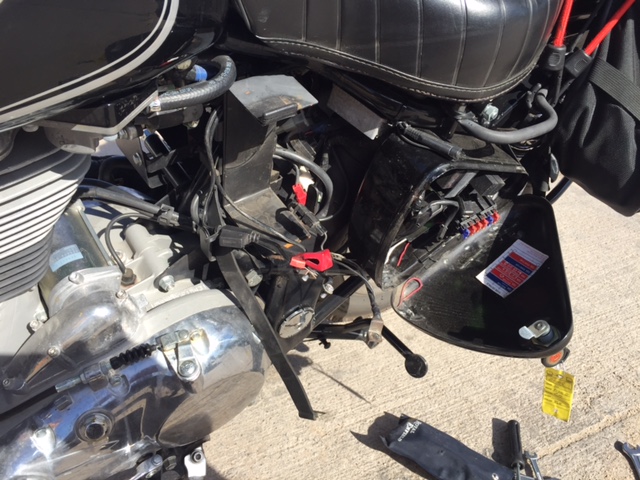 With wires dangling and the larger battery hanging out the left side of the frame our Bullet is looking more like a BMW adventure bike everyday. If we wrapped 75 feet of 3/4 inch electrical conduit around the Bullet you’d swear it was a GS1200. Despite the troubles the thing is growing on us. Really, none of the faults are due to Royal Enfield assemblies.
With wires dangling and the larger battery hanging out the left side of the frame our Bullet is looking more like a BMW adventure bike everyday. If we wrapped 75 feet of 3/4 inch electrical conduit around the Bullet you’d swear it was a GS1200. Despite the troubles the thing is growing on us. Really, none of the faults are due to Royal Enfield assemblies.